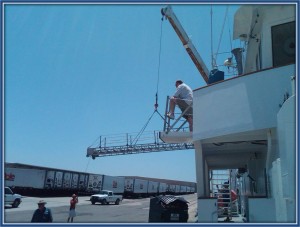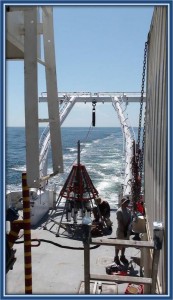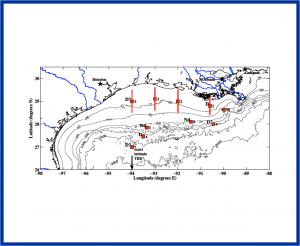Adieu to Dry Land
 The true reality of this commitment sank in as the gangplank was raised this morning: we are aboard this ship for 22 days, there will be no last minute trips to the store any more! As soon as we were away from the dock, and safely escorted out of the Gulfport, MS harbor by their pilot boat
The true reality of this commitment sank in as the gangplank was raised this morning: we are aboard this ship for 22 days, there will be no last minute trips to the store any more! As soon as we were away from the dock, and safely escorted out of the Gulfport, MS harbor by their pilot boat  and a pod of dolphins, it was on to business. We were given an orientation regarding the ship’s safety measures and then after we had an overview of the next few days of activity.
and a pod of dolphins, it was on to business. We were given an orientation regarding the ship’s safety measures and then after we had an overview of the next few days of activity.
We will be steaming to our first drop point to take sediment samples and water samples for the next 25 hours or so. During the day today, the science team will be prepping for  tomorrow’s and future samplings. All of the instruments and collection vessels must be prepped, sterilized, and checked to ensure they work properly. We later had the chance to learn about the process the techs use to prepare, monitor, deploy, and recover the CTD (conductivity, temperature, depth) rosette.
tomorrow’s and future samplings. All of the instruments and collection vessels must be prepped, sterilized, and checked to ensure they work properly. We later had the chance to learn about the process the techs use to prepare, monitor, deploy, and recover the CTD (conductivity, temperature, depth) rosette.
Our tentative path of study, with deployment points, is on the map below. If you notice the whiskers on the box plot, it is because water chemistry must be conducted first before the landers are set on the sea floor; this type of research is much more selective than simply tossing a dart at a map, which is why our course remains tentative. Each of the sites is based upon predictions of the dissolved oxygen levels in the water, and before setting out to collect sediment samples from areas known to be hypoxic and anoxic, we must first establish that they remain below 2 parts per million of oxygen, as well as what the salinity and temperature are at that location. As the cruise progresses, and as the most current parameters of the hypoxic plume are published within the next few days, our path can and will change. You can follow our true course on the expedition map, or even have students plot our latitude and longitude on their own map.
At the end of the day, we were all briefed on tomorrow’s activities. We will begin deployment of the CTD early in the morning, and work on establishing the first drop point near noon. Then the fun begins, with bringing up sediment samples from the lander, and seeing what exchange has occurred between oxygen in the water and iron in the sediment.


 July 31, 2011
July 31, 2011 







Recent Comments